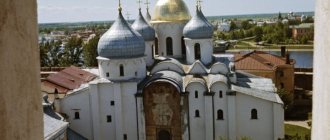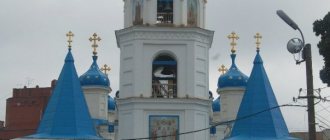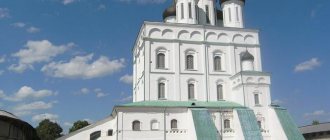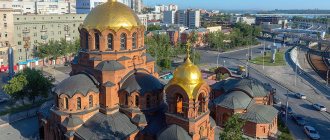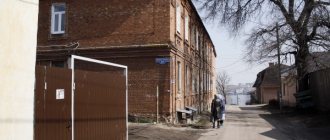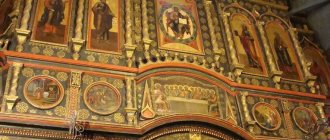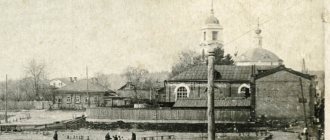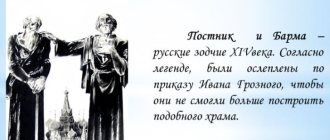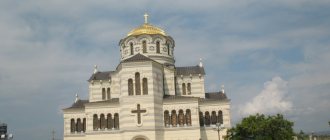Mir
Russia Altai Territory Barnaul Intercession Cathedral (Barnaul) Map loading in progress...
{"format":"leaflet","minzoom":false,"maxzoom":false,"limit":50,"offset":0,"link":"all","sort":[""], "order":[],"headers":"show","mainlabel":"","intro":"","outro":"","searchlabel":"\u2026 \u0441\u043b\u0435\ u0434\u0443\u044e\u0449\u0438\u0435 \u0440\u0435\u0437\u0443\u043b\u044c\u0442\u0430\u0442\u044b","default":"","import-annotation":false,"width ":"auto","height":"350px","centre":{"text":"","title":"""link":"""lat":53.3296332999999975754690240137279033660888671875,"lon": 83.7744167000000032885509426705539226531982421875,"icon":""},"title":"","label":"","icon":"","lines":[],"polygons":[],"circles":[ ],"rectangles":[],"copycoords":false,"static":false,"zoom":8,"defzoom":14,"layers":["OpenStreetMap"],"image layers":[] ,"overlays":[],"resizable":false,"fullscreen":true,"scrollwheelzoom":true,"cluster":false,"clustermaxzoom":9,"clusterzoomonclick":true,"clustermaxradius":80, "clusterspiderfy":true,"geojson":"","clicktarget":"","showtitle":true,"hidenamespace":false,"template":"","userparam":"","activeicon": "","pagelabel":false,"ajaxcoordproperty":"","ajaxquery":"","locations":[{"text":"\u003Cb\u003E\u003Ca href=\"/palomnik/%D0% 9F%D0%BE%D0%BA%D1%80%D0%BE%D0%B2%D1%81%D0%BA%D0%B8%D0%B9_%D1%81%D0%BE%D0%B1% D0%BE%D1%80_(%D0%91%D0%B0%D1%80%D0%BD%D0%B0%D1%83%D0%BB)\» title=\»\u041f\u043e\u043a\ u0440\u043e\u0432\u0441\u043a\u0438\u0439 \u0441\u043e\u0431\u043e\u0440 (\u0411\u0430\u0440\u043d\u0430\u0443\u043b)\u003E \u041f\u043e\u043a\ u0440\u043e\u0432\u0441\u043a\u0438\u0439 \u0441\u043e\u0431\u043e\u0440 (\u0411\u0430\u0440\u043d\u0430\u0443\u043b)\u003C/a \u003E\u003C/b\ u003E\u003Chr /\u003E\u003Ca href=\»/palomnik/%D0%A1%D0%B2%D0%BE%D0%B9%D1%81%D1%82%D0%B2%D0%BE:%D0 %90%D0%BD%D0%BD%D0%BE%D1%82%D0%B0%D1%86%D0%B8%D1%8F\" title=\"\u0421\u0432\u043e\u0439\u0441 \u0442\u0432\u043e:\u0410\u043d\u043d\u043e\u0442\u0430\u0446\u0438\u044f\»\u003E\u0410\u043d\u043d\u043e\u0442\u0430\u0446 \u0438\u044f\u003C/ a\u003E: "'\u041f\u043e\u043a\u0440\u043e\u0432\u0441\u043a\u0438\u0439 \u043a\u0430\u0444\u0435\u0434\u0440\u0430\u043b\u04 4c\u043d\u044b\u0439 '' 40\u0430\u043c\u0432\u0411 \u0430\u0440\u043d\u0430\u0443\u043b\u0435, \u0441 40-\u0445 \u0433\u043e\u0434\u043e\u0432 XX \u0432\u0435\u043a\u0430 \u04 3a\u0430\u0444\u0435\u0434 \u0440\u0430\u043b\u044c\u043d\u044b\u0439 \u0441\u043e\u0431\u043e\u0440 \u0411\u0430\u0440\u043d\u0430\u0443\u043b\u044c\ u0441\u043a\u043e\u0439\u0435 \u043f\u0430\u0440\u0445\u0438\u0438.","title":"\u041f\u043e\u043a\u0440\u043e\u0432\u0441\u043a\u0438\u0439 \u0441\u043e\u0431\ u043e\u0440 (\u0411\u0430\u0440\u043d\u0430\u0443\u043b)","link":"","lat":53.3296332999999975754690240137279033660888671875,"lon":83.774416700000 0032885509426705539226531982421875,"icon":""}],"imageLayers": []}
53.329563; 83.774431
Russia, Altai Territory, Barnaul, Nikitina street, 137
Barnaul, Altai region 656008
Russia
Telephone:
+7 (3852) 63-62-16
Email:
Intercession Cathedral
- an Orthodox church in Barnaul, since the 40s of the 20th century, the cathedral of the Barnaul diocese.
History[edit]
In 2004, the Intercession Cathedral celebrated its 100th anniversary. But the history of the appearance of the first Church of the Intercession goes back to more distant times - to the middle of the 19th century. It was at this time that many residents of the European provinces of Russia, who suffered from land shortages, began to move to Altai. Some of the settlers settled in Barnaul. As a rule, people settled behind Konyushenny Lane (today Krasnoarmeysky Avenue), on the western outskirts of the city, later called Zaichanskaya Sloboda or simply Zayachya. The settlement quickly grew towards the Pivovarka River, and the nearest church - St. Demetrius of Rostov - was located in the city center, on Demidovskaya Square, that is, at a considerable distance from Zayachaya. At this time, it was decided to build a new brick Znamensky Church, and it was decided to dismantle the old wooden church in the name of the holy righteous Zechariah and Elizabeth and, according to its plan, build the Church of the Intercession of the Blessed Virgin Mary with the chapel of the Holy Blessed Prince Alexander Nevsky in Zayacheya Sloboda. The blessing for this good deed was given by Tomsk Bishop Parfeniy on November 20, 1859.
After a very short time - and it was necessary for the delivery of building materials and some organizational work - construction began in 1860. During the construction of the new temple, they began to use the well-preserved logs of the Znamenskaya Church, which had been dismantled by that time. Residents of Zaychanskaya Sloboda considered it an honor to take part in this holy cause, so the Church of the Intercession was built in a fairly short time: on August 4, 1863, the consecration of the temple took place.
The Church of the Intercession was located in the poorest part of Barnaul. Its parishioners were peasants, townspeople, artisans and other artisans. Therefore, taking into account the impossibility of maintaining the temple with their meager donations, the Tomsk Consistory - and the Altai Mountain District of the Cabinet of His Imperial Majesty was then part of the Tomsk Diocese - assigned the Intercession Church to the Cathedral of Peter and Paul, which was supposed to help the Hare Sloboda maintain its temple in splendor. This rule was strictly observed throughout the second half of the nineteenth century and even into the early twentieth.
However, the territory of Zayacheya Sloboda was rapidly expanding, and by the early eighties of the 19th century, the Church of the Intercession could not accommodate all the believers within its walls. On their own initiative, parishioners began to raise money for the construction of a new, more spacious church. They collected it all over the world, but, despite the donations of the Barnaul merchants, it took quite a long time: the amount necessary for construction was collected only by 1898. On August 9 of the same year, the first stone was laid in the foundation of the future temple. In 1903, the construction of the church was completed, and the consecration took place on September 29, 1904.
As mentioned above, the Church of the Intercession was located in the poorest part of the city and its parishioners were not able to pay for the education of their children. The rector of the church, Archpriest John Smirnov, took care of this. On his initiative, the first parochial schools for boys and separately for girls were opened at the Intercession Church in the early nineties of the 19th century. But they were clearly not enough, and soon after the completion of the construction of the stone Church of the Intercession of the Blessed Virgin Mary, Father John Smirnov commissioned the famous Barnaul architect Ivan Nosovich to design a new, brick parochial school. Soon this building was built. It was located on the corner of Pavlovskaya (Anatoly) street and Third Prudsky (Yadrintseva) lane. It was the largest parochial school in Barnaul. It should be noted that this building has always been used for its intended purpose - after the October Revolution, school number 13 was located in it. It is gratifying to note the fact that the modern management of the school has not forgotten its historical roots and has been counting the time in its educational institution since 1892 - the year creation of the first parochial school at the Church of the Intercession. School number 13 celebrated its 110th anniversary in 2002.
During the years of revolutionary timelessness and the atheistic regime, the Church of the Intercession fully survived the trials that befell the Russian Orthodox people: atheists fired at it during Holy Week of 1918, and robbed it in the early twenties. On April 10, 1939, the church was closed.
The Church of the Intercession, by the providence of God, was one of the last to stop worshiping in Altai and was not destroyed like most churches in Barnaul. Many of its priests and parishioners were arrested, shot, and sent to prisons and camps. But during the hard times of war, the temple was reopened - in January 1944, its restoration began...
How are services held in the temple?
Currently, services in the cathedral are held daily. From Monday to Saturday, the Liturgy begins at 8.30, evening worship at 16.00. On Sundays, the early Liturgy begins at 7.30, the second at 9.30.
Services in the church are held on Orthodox holidays: on Holy Easter and Bright Week, on the days of the initial week of Lent and Holy Week.
Divine services are held on all twelve and major holidays: the Nativity of Christ, Epiphany and Ascension of the Lord, Trinity, Annunciation, Exaltation of the Cross, Intercession, on the days of remembrance of the holy prophet John the Baptist, St. apostles: Evangelist John the Theologian, Supreme Peter and Paul, Andrew the First-Called, Saint and Wonderworker Nicholas, Blessed Prince Alexander Nevsky, lordly and Mother of God celebrations (icons of the Sign, Kazan, Smolensk Hodegetria) and others according to the Orthodox calendar.
This video tells about the festive service in honor of the Kazan Icon of the Mother of God.
Current state[edit]
There is a Sunday school at the temple.
Description[edit]
A large brick unplastered temple in pseudo-Russian style. The building is cruciform in plan with a rotunda under an onion dome above the middle cross and a pillar-shaped bell tower above the western part. The interior of the temple on religious subjects of paintings by masters of Russian academic painting M.V. Nesterov, V.M. Vasnetsov, I.N. Kramskoy was painted with oil paints on dry plaster in 1918 - 1928 with the participation of the artist N.V. Shvarev. He also drew up the painting project.
Architecture and decoration of the building
Many decades after its founding, the Barnaul Cathedral continues to win the hearts of parishioners with its external and internal decoration. During the years of the foundation of the cathedral, the fashion for the architecture of ancient Russian architecture prevailed in the Russian Empire. Thus, the Intercession Cathedral became a striking example of the pseudo-Russian, or otherwise Byzantine, style in architecture.
Appearance
The walls of the church are made of red unplastered brick, which at the time of the construction of the temple stood out favorably against the background of pale stone buildings. The temple was built in pseudo-Russian style, the layout is classical, cruciform. Above the middle cross rises an onion dome on a round rotunda. The bell tower in the western part of the building was restored in 1990. The cathedral is crowned with five domes decorated with golden crosses.
The throne is the sacred place of any Orthodox church. It is here that the main religious sacraments are performed, for example, the Eucharist or ordination.
There are four thrones in the Barnaul shrine:
- Main altar of the Intercession of the Blessed Virgin Mary
- Throne of Alexander Nevsky
- Throne of Panteleimon the Healer
- The lower chapel of Seraphim of Sarov.
Interior design
Inside the temple is painted with religious scenes from paintings by Nesterov, Vasnetsov and Kramskoy. The complete painting project was drawn up by artist N.V. Shvarev.
Despite the fact that the cathedral became accessible to parishioners in the early years of the 20th century, its interior painting took more than a decade. Only by 1928 the cathedral finally acquired its finished form. This happened thanks to the local painter N.V. Shvarev, who, without fear of the wrath of the Bolshevik authorities, painted the walls of the temple with frescoes with religious motifs for ten years. Many icons kept in the church also belong to the brush of this artist.
Temple shrines
The temple contains three miraculous icons with particles of holy relics:
- Blessed Matrona;
- Great Martyr Healer Panteleimon;
- Reverend Prince Alexander Nevsky.
People ask them for healing from illnesses, help in business, and family well-being.
Church of St. Demetrius of Rostov (Barnaul)[edit]
Dimitrievskaya Church is currently the oldest temple in Barnaul. There were churches in our city with a more respectable age - for example, the Peter and Paul Cathedral, the Church of the Mother of God-Hodegetrievskaya - but in godless times they were destroyed, and now in their place there are slightly ennobled wastelands, loudly called public gardens. And the Dimitrievskaya Church miraculously survived. Maybe because it was deliberately disfigured by various extensions from the 30s of the 20th century, it didn’t even look like a temple...
By God's providence the mystical connection of times is preserved. The priest of the Dimitrievskaya Church, Alexander Abrashkin, having learned the history of the temple, decided to commemorate the deceased Archpriest John of Goretovsky. On the very first day of commemoration after the Divine Liturgy, one of the pious parishioners told Father Alexander that she saw a gray-haired priest in white vestments in the altar at the altar... And on May 22 of this year, a tombstone was found from the grave of Deacon Theodore Golubinsky, who served for many years in the Demetrius Church...
Address
: 656043, Barnaul, pl. Spartak, 10.
Telephone
: (3852) 63-96-30
Iveron Seminary Church (Barnaul)[edit]
The temple in honor of the Iveron Icon of the Mother of God was built on the territory of the Barnaul diocesan administration in the late 1990s under the care of Bishop Anthony (Masendich) of Barnaul.
On September 20, 2013, with the blessing of Bishop Sergius (Ivannikov) of Barnaul, regular services began to be held in the church, and from then on it was called the seminary church.
Address:
656008, Altai Territory, Barnaul, lane. Yadrintseva, 66
Telephone:
+7 (3852) 68-03-81
Email:
Hard times
For many years after its construction, the Barnaul Cathedral was a haven for many Orthodox believers from all over the Altai region. However, during the years of Soviet power, during large-scale anti-religious propaganda, difficult times came for the temple.
There is a lot of evidence of acts of vandalism against Orthodox churches and many facts of the destruction of holy places. The Bolsheviks fired at the building during Holy Week of 1918 and looted it in the early twenties.
On April 10, 1939, the church was closed and the premises were used as warehouses for storing feed for livestock. The Intercession Church was one of the last to stop worshiping in Altai and was not destroyed, writes proreligiu.club.
Temple of the Apostle John the Theologian (Barnaul)[edit]
The parish of the Apostle and Evangelist John the Theologian was officially registered in April 1996, and already in May of the same year, His Eminence Anthony (Masendich, +2001) consecrated a cross and a stone on the site of the future temple. For more than a year, the stone and the cross stood in an open field...
The first de facto rector of the parish was Hegumen Alexy (Prosfirin), who was able to quickly organize his spiritual children. With their help, within one month, a “box” of temporary premises for worship was erected. On October 9, 1997, the patronal feast day, the first liturgy was celebrated. This day can be considered the birthday of the parish. The temporary structure was built quickly, and soon they expected to begin construction of the main temple.
Temple rector
: Archpriest Georgy Kreidun.
Address
: 656058, Barnaul, Shumakova st., 25a
Telephone
: (3852) 45-57-52,
Alexander Nevsky Cathedral (Barnaul)[edit]
Construction of the Alexander Nevsky Cathedral began in 1991.
The Church of the Epiphany was founded in 1992, and its consecration took place in 1995.
The cathedral itself was founded at the same time. The cathedral complex includes: a cathedral under construction, the Church of the Epiphany, a small belfry, a water-blessing chapel, an icon shop, and a church guardhouse in the form of a tower.
Address:
656054, Barnaul, st. Anton Petrov, 221.
Phone number of the icon shop:
+7 (923) 005-55-52
Security telephone:
+7 (923) 565-55-52
Email:
Revival that began during the war years
It is well known that during the war, in order to raise the patriotic spirit of the population and for its closer unity in the fight against the enemy, the government decided to open a number of Orthodox churches that had previously been taken away from the Church. Among them was the Intercession Cathedral of Barnaul, which was returned to believers in 1943. From that time on, his slow but consistent recovery began.
It should be noted that from the end of the war until the mid-eighties, there were hardly three or four functioning churches in the entire Altai Territory. This circumstance determined the role of the Intercession Cathedral as a leading spiritual center. Believers from a vast area came to it, and all services were held, as a rule, in a crowded room.
St. Nicholas Church (Barnaul)[edit]
And on the central street of Barnaul – Moskovsky Prospekt – a soldier’s (or regimental) St. Nicholas Church appeared. At the beginning of the 20th century, there was a rule in Russia according to which in those areas where Russian military forces of at least a battalion were stationed, it was necessary to build soldiers’ churches, and where this was impossible, military military churches and even carriage churches began to appear. The Barnaul Rifle Regiment was located in the city at that time, so the question of building a temple was a foregone conclusion, especially since the military department allocated 36 thousand rubles for this purpose, and the General Staff proposed a project for a brick church accommodating 630 people, and this project was approved by the Sovereign Emperor Nicholas II.
Nowadays, St. Nicholas Church is gradually being restored. The famous Barnaul artist V. Konkov completed its interior painting, a new iconostasis, painted by Palekh icon painters, was ready, and a new bell tower was erected. It is planned to erect a dome - and then the acoustics in the altar will improve, and again, as once upon a time, the words of the Orthodox service will be heard in full force for the parishioners: “Blessed is our God always, now and ever and unto ages of ages.”
Address
: 656038, Barnaul, Lenin Avenue, 36
Telephone
: (3852) 35-49-75
Church of St. Anthony of Kiev-Pechersk and Orthodox Rehabilitation Center (Barnaul)[edit]
The Church of St. Anthony of Kiev-Pechersk was built in 2002-2010; There is a counseling center for drug addicts at the temple. Patronal holidays: July 23, the day of remembrance of St. Anthony of Kiev-Pechersk; September 15, Memorial Day of St. Anthony of Pechersk and St. Theodosius of Pechersk; October 11, Cathedral of St. fathers of the Kiev-Pechersk, resting in the Near Caves.
Address:
Altai Territory, Barnaul, Lenin Ave., 149-A, bldg. 2
Tel.:
8 (905) 928-35-34 (temple); 8 (963) 517-33-11 (rehabilitation center; Dmitry Mikhailovich, 24 hours a day)
Email:
Official site
The temple, which became the decoration and pride of the city
All work was carried out with funds donated by the townspeople, among whom the local merchants showed particular generosity. The newly built cathedral, which soon received the status of a cathedral, became one of the leading religious centers of the diocese and was an outstanding work of temple architecture.
His project was designed in the then fashionable pseudo-Russian, or, as it is also called, Byzantine style, with a five-domed structure characteristic in such cases. Built of red brick, with crosses shining in the sun, the Intercession Cathedral of Barnaul contrasted sharply with the dull buildings of the working-class district that surrounded it.
The cathedral that became a national shrine
Today, when parish churches are open in almost all regional centers, residents of the region consider it their sacred duty to visit it every time they find themselves in Barnaul due to certain circumstances. Tribute to the memory of previous years and deep reverence for the shrines stored in it force them to visit the Intercession Cathedral (Barnaul) again and again. Its address (Nikitin St., 137) is also well known to those who, having not yet joined religion, show interest in the past of their city and its cultural and historical heritage.
